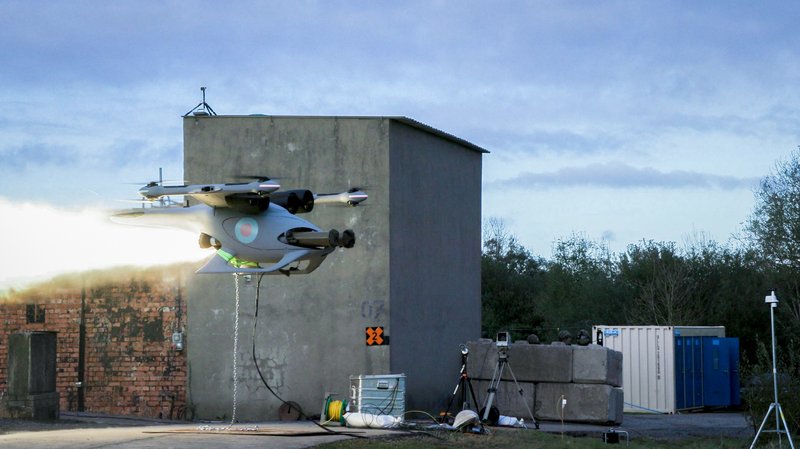IMDEX 2023: Flyby and Thales look to further Jackal development after successful missile firing
The Jackal drone pictured during RAF RCO trials. (Photo: Flyby/Thales)
Under an RAF Rapid Capabilities Office (RCO) sponsored trial in April, a Thales LMM was fired from a FlyBy Technologies Jackal drone in a milestone for developing uncrewed combat air capabilities.
The Jackal, designed by UK-based Flyby with Turkish partners FlyBVLOS Technology and Maxwell Innovations, providing design engineering and prototyping expertise, is geared towards filling a gap in modern operations such as air interdiction and close air support.
Speaking to Shephard, Flyby founder Jon Parker said the aircraft had capability across the domains of air, land and sea, touting the Jackal's ability to fulfil a range of missions.
Related Articles
RCO defends Project Mosquito cancellation, claiming investment stopped making sense
IMDEX 2023: Israel Shipyards courts interest in OPV S-45 and S-80 Corvette
IMDEX 2023: New Chinese-built LPD arrives in Thailand
One such mission could be naval gunfire support, given the UK's adoption of the LMM weapon, better known as Martlet, on the RN's Wildcat helicopters.
The duo of Thales and Flyby are also exploring the integration of the Free-Fall LMM, designed for lightweight aircraft and UAS, onto the Jackal aircraft seeing it as a complementary capability.
For the RCO trial, Flyby and Thales produced two operational Jackal aircraft and fired two LMMs.
Jackal is designed as a plug-and-play system, allowing new equipment and technology to be easily integrated into the drone between missions.
This process is seen as helping to keep the aircraft relevant with a spiral development approach, as Parker explained that once a UAV is on the ground, it quickly becomes obsolete due to the pace of change.
He added that the aircraft could also be used as a 'pipe-cleaner' to help generate future regulatory compliance and airworthiness standards that do not slow down the ability to get novel capabilities into service.
The UK currently restricts the flight of drones weighing over 25kg in its airspace.
Flyby was asked to brief the RAF RCO on the aircraft following the Russian invasion of Ukraine. The company also contacted Thales to explore the possibility of firing LMM in the trial.
The two aircraft were built, and the two missiles were fired from the platforms within six weeks.
Parker said: 'War is about winning, and Jackal is designed by warfighters for that ultimate aim. The days of having a fighter pilot in the cockpit are numbered, and I realise I will not perhaps be loved for bringing about the end of my own kind. But the future of warfare is changing, and Jackal is part of that future as a true multi-role attack aircraft.
'We want to make Jackal a flagship product, creating secure UK jobs and contributing to a new future for the British aerospace and defence industries.'

During the trials, two LMM weapons were fired from the Jackal platform. (Photo: Flyby/Thales)
Having successfully demonstrated the missile firing, work is now going into the productionisation of the platform and further tactical development.
Marinisation of the platform to make it suitable for naval applications is a part of this process.
Jackal was originally designed and developed by Flyby, FlyBVLOS Technology and Maxwell Innovations, with the team flying and testing the aircraft at a dedicated range in Turkey.
Development will continue in Turkey and the UK, and the company is seeking UK partners to manufacture the aircraft at scale. Work is also going into designing weapons suited to the Jackal and its role as an attack drone.
The company sees LMM as an ideal starting point to continue with further weapons experimentation.
RFA RCO head Air Cdre Jez Holmes said: 'Given the impressively short time scale it took the team to deliver the initial trial, it's clear that Flyby could have an exciting future in this sector, and the partnering and support from Thales was outstanding in lowering the barriers to entry for innovative start-ups.
'I'm looking forward to seeing the ongoing developments in this area.'
Thales Surface Attack Products line manager James Keown told Shephard that integrating LMM into the drone benefited from the weapon's multi-role nature and the existing development that went into equipping the RN's Wildcats with the missile.
A crucial part of the trial was that it demonstrated that Jackal could fire the missile without disturbing the platform's flight.
Keown added that planning was going into establishing an architecture that would allow the Jackal to deploy other munitions. The ambition was to equip the platform with the Free-Fall LMM.
He described Jackal as a 'natural choice' for the weapon as another vector to deploy it from. The system also allows exploring the use of LMM in land attack scenarios.
Thales Northern Ireland MD Philip McBride said: 'One of the unique selling points of LMM is its ability to be integrated onto multiple platforms, including armoured vehicles, helicopters, naval vessels or indeed, shoulder launchers, each designed to address different threats.
'It has been a privilege to work with the Flyby team on this time-compressed and ground-breaking trial, and has proved that both Thales and Flyby can produce impressive and agile results when focussed on a collective, shared objective.'
LMM is among the advanced missiles that have been supplied to Ukraine by the UK in support of its ongoing defence against the Russian invasion.
Related Equipment in Defence Insight
More from IMDEX Asia 2023 Show News
-
![Philippine frigates progressively advance operational capability]()
Philippine frigates progressively advance operational capability
A couple of years into their service, the Philippine Navy continues to improve and test its two South Korean-built frigates.
-
![IMDEX 2023: MBDA and PGZ partnership includes ‘deep industrial cooperation’ on CAMM-ER]()
IMDEX 2023: MBDA and PGZ partnership includes ‘deep industrial cooperation’ on CAMM-ER
MBDA has confirmed that work with Poland on land and maritime air defence includes cooperation on the extended-range version of the Common Anti-Air Modular Missile (CAMM), known as CAMM-ER.
-
![Exclusive: Royal Navy Second Sea Lord on ships, the defence command paper, and the future Indo-Pacific presence]()
Exclusive: Royal Navy Second Sea Lord on ships, the defence command paper, and the future Indo-Pacific presence
The UK Royal Navy’s Second Sea Lord VAdm Martin Connell said it shouldn’t be a surprise that adjustments must be made ahead of a hotly anticipated new Defence Command Paper and praised the progress made by HMS Tamar and Spey in reinforcing the UK’s commitment to the Indo-Pacific.
-
Abeking & Rasmussen prepares to hand over Indonesian minehunters
Later this month, the German shipbuilder will deliver two minehunters to the Indonesian Navy.
-
![IMDEX 2023: Fincantieri seeks to satisfy conditions for Indonesian FREMM frigate deal]()
IMDEX 2023: Fincantieri seeks to satisfy conditions for Indonesian FREMM frigate deal
Italian shipbuilder Fincantieri is continuing to work with Indonesia to satisfy the conditions for a FREMM frigate contract to enter into effect.
-
![IMDEX 2023: New Chinese-built LPD arrives in Thailand]()
IMDEX 2023: New Chinese-built LPD arrives in Thailand
A new Chinese-built LPD, HTMS Chang, arrived in Thailand in late April, having been collected by the Royal Thai Navy earlier that month.

























